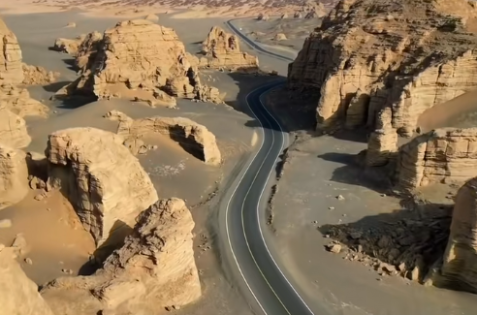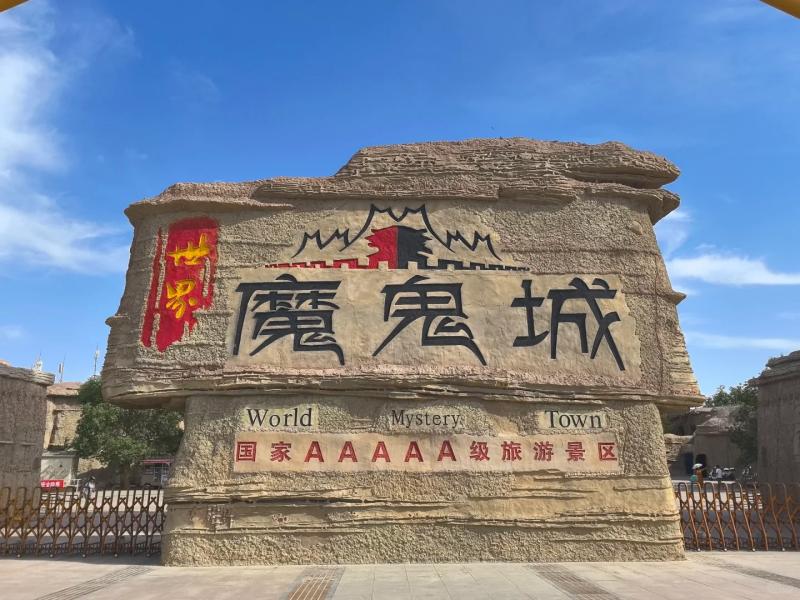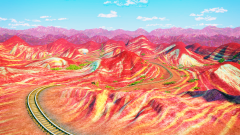Hidden deep in the deserts of northwestern China lies one of nature’s strangest masterpieces—the Yardang landforms of Dunhuang and Hami. Shaped by relentless wind erosion over millions of years, these surreal formations rise from the sand like ghostly castles, ships, and fortresses. For travelers crossing the Gobi, Yardang landscapes are not just geological wonders—they are an encounter with time itself.
What Is a Yardang?
The term Yardang originates from a Uyghur word meaning “steep bank.” These formations are carved when strong, persistent winds blow across soft sedimentary rocks, slowly eroding them into ridges and valleys. The harder rock layers remain standing, while softer ones are blown away, creating narrow, elongated hills aligned with the direction of the wind.

Yardangs can range from a few meters to several hundred meters in height, resembling natural sculptures scattered across a vast sea of sand.
Dunhuang Yardang National Geopark – The “City of Ghosts”
Located about 180 km west of Dunhuang, the Yadan National Geopark (also called the “Ghost City”) is the most famous Yardang landscape in China. Spread across more than 400 square kilometers, it offers visitors an almost otherworldly experience.
What to See:
-
The Ghost City Sound: When strong winds sweep through the Yardang corridors, they create eerie howls and whistles—hence the nickname “Ghost City.”
-
Natural Sculptures: Over thousands of years, the wind has shaped rocks into recognizable forms—ships, camels, pagodas, even a “Sleeping Beauty.”
-
Sunset Views: As the sun sinks, the Yardangs glow golden-red, and the shadows stretch endlessly across the sand—one of the most photogenic moments in the Gobi Desert.
How to Visit:
From Dunhuang, travelers can reach the geopark via a 3-hour drive. Electric sightseeing cars within the park take visitors to multiple viewpoints, including the famous “Shipwreck Rock” and “Lion Pavilion.”
Hami Yardang – The Hidden Desert Sculpture Garden
While Dunhuang’s Yardangs are well-known, the Hami Yardang National Geopark remains a hidden gem in Xinjiang. Located near the eastern edge of the Turpan-Hami Basin, this area is wilder and less visited—perfect for travelers seeking solitude and raw desert beauty.

Features of Hami Yardang:
-
Scale and Variety: The formations stretch for over 100 km, featuring cliffs, canyons, and labyrinth-like passages.
-
Color and Texture: Compared to Dunhuang’s warm tones, Hami’s Yardangs appear darker and sharper, sculpted by harsher winds.
-
Remote Serenity: Few tourists venture here, allowing for uninterrupted exploration and photography opportunities.
Travel Tip:
Due to limited public transportation, the Hami Yardang area is best accessed by private car or guided tour from Hami City. Be sure to bring plenty of water, sun protection, and a good camera—there are no services in the desert.
How Yardangs Were Formed – A Geological Story
The creation of Yardang landscapes in Dunhuang and Hami dates back millions of years, when ancient lakes and rivers once covered the region. Over time, the climate grew drier, and powerful northwesterly winds began carving the exposed lakebed sediments into sharp ridges.
Geologists believe that some Yardangs in Dunhuang formed around 700,000 years ago—a living record of the desert’s transformation. Even today, wind erosion continues to reshape them, making the landscape dynamic and ever-changing.
Cultural and Historical Connections
Beyond geology, Yardangs are also intertwined with Silk Road history and folklore.
-
Silk Road Route: Both Dunhuang and Hami were important stops on the ancient trade route linking China with Central Asia. Caravans once passed near these wind-sculpted hills, using them as landmarks in the vast desert.
-
Legends and Myths: Locals say the howling winds are the voices of ancient spirits wandering through the desert ruins. This belief gave rise to the haunting name “Ghost City.”
-
Artistic Inspiration: The strange beauty of the Yardangs has inspired countless photographers, painters, and even film directors—many scenes of Chinese desert movies were shot in these locations.
When to Visit
The best time to visit the Yardang areas is from April to October, when temperatures are moderate, and the skies are clear. In summer, expect strong sunlight and dry heat, while winter visits reveal a quieter, more mysterious side of the desert.
Tip for photographers: Visit during early morning or sunset hours for the most dramatic lighting and shadow contrasts on the rock formations.
Travel Tips for Visitors
-
Bring Essentials: Sunglasses, sunscreen, a hat, and plenty of water.
-
Avoid Midday Heat: Desert temperatures can exceed 40°C in summer.
-
Stay on Designated Paths: Yardangs are fragile and constantly eroding—walking off-path can damage them and be dangerous.
-
Combine with Nearby Attractions: Pair your visit with Mogao Caves in Dunhuang or Hami King’s Tomb and Hami Museum for a richer cultural experience.
Conclusion
The Yardang landforms of Dunhuang and Hami are living sculptures shaped by wind, time, and silence. They stand as monuments to nature’s artistry and the endurance of the desert itself. For travelers seeking mystery and solitude, few places compare to these vast stone cities rising from the sands.
To plan your desert adventure and discover more hidden wonders of northwestern China, visit China Dragon Travel’s official website for customized Silk Road and Xinjiang travel experiences.














